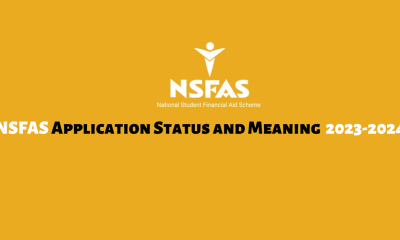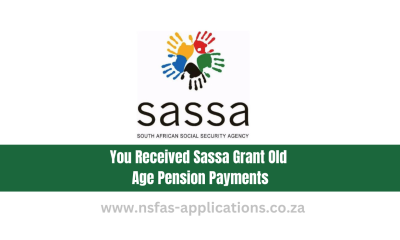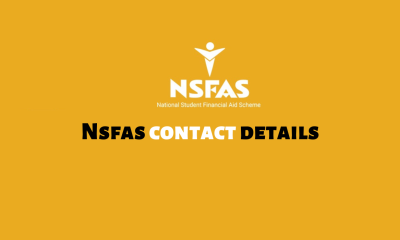NSFAS News
My NSFAS Status Check Balance

My NSFAS Status Check Balance. Managing your finances while pursuing higher education can be challenging, especially when you’re reliant on funding from the National Student Financial Aid Scheme (NSFAS). One of the most critical aspects of managing these funds is regularly checking your NSFAS balance. In this guide, we’ll explore how to check your NSFAS balance, why it’s essential, and some helpful tips for effectively managing your student financial aid. With this detailed guide, you’ll be equipped to navigate your financial journey with NSFAS successfully.
NSFAS and Its Importance
The National Student Financial Aid Scheme (NSFAS) is a government initiative aimed at providing financial assistance to South African students from disadvantaged backgrounds. For many students, NSFAS is the gateway to higher education, offering the funds necessary to cover tuition fees, accommodation, transport, study materials, and other related expenses.
Given the importance of these funds, managing your NSFAS account properly is critical. Knowing your balance ensures that you’re always aware of the available funds and can plan your finances accordingly. Let’s dive into how to check your NSFAS balance and stay on top of your financial aid.
Why Checking Your NSFAS Balance Is Essential
Staying informed about your NSFAS balance isn’t just about knowing how much money you have left. It plays a key role in maintaining your financial well-being while studying. Here are a few important reasons why you should regularly check your balance:
1. Effective Budgeting
When you know the exact amount of money you have left in your NSFAS account, you can plan your spending more efficiently. It helps ensure that you allocate your funds toward essentials such as tuition, accommodation, food, and study materials without running short unexpectedly.
2. Avoiding Financial Shortfalls
By regularly checking your balance, you can prevent any sudden or unexpected shortages of funds. This is especially important during critical times, such as exam periods when financial distractions can impact your focus and performance.
3. Monitoring Transactions
Regularly reviewing your NSFAS account allows you to track all transactions and disbursements. You can ensure that all payments are correct and spot any discrepancies, preventing issues that could impact your financial aid.
Step-by-Step Guide: How to Check Your NSFAS Balance
There are multiple ways to check your NSFAS balance. Whether you prefer using your mobile phone or checking online, the process is simple and quick. Below are the most common methods.
1. Checking NSFAS Balance Using USSD Code
One of the easiest ways to check your NSFAS balance is by using the USSD code. This method doesn’t require internet access, and you can check your balance from any mobile phone. Here’s how to do it:
- Dial the USSD Code: Start by dialing 134176# on your mobile phone.
- Enter Your Password: You will be prompted to enter the password that you set up when registering for the NSFAS Wallet. Make sure to enter it carefully to avoid errors.
- Select ‘Check Balance’ Option: After logging in, a menu will appear. Select option 2, labeled “Query,” which allows you to check your balance and review recent transactions.
- View Your Balance: Your NSFAS cash balance and a list of recent transactions will be displayed on your phone. This information is updated in real-time.
2. Checking NSFAS Balance Online via MyNSFAS Portal
You can also check your NSFAS balance online through the MyNSFAS portal. This method requires an internet connection and is a more comprehensive way to manage your account. Follow these steps:
- Visit the NSFAS Website: Open your browser and go to www.nsfas.org.za.
- Log into Your Account: Enter your login credentials (ID number and password) to access your account.
- Navigate to the ‘MyNSFAS’ Portal: Once logged in, click on the “MyNSFAS” tab to view your account dashboard.
- Check Your Balance: On the dashboard, you’ll find your NSFAS balance as well as other details about disbursements and outstanding amounts.
- Verify Your Information: Double-check your personal details, such as banking information, to ensure everything is accurate.
Why It’s Crucial to Check Your NSFAS Balance Regularly
Monitoring your NSFAS balance should become a habit. Let’s break down why regular balance checks are so important:
- Financial Control: Regularly checking your balance allows you to stay in control of your funds. You’ll know exactly where your money is going and how much you have left.
- Identify Issues Early: If there are any delays or errors in your payments, you’ll be able to spot them immediately and take action before they become bigger problems.
- Avoiding Unnecessary Debt: Keeping a close eye on your balance helps ensure that you don’t overspend, preventing you from accumulating unnecessary debt.
Best Practices for Managing Your NSFAS Funds
Managing your NSFAS funds wisely is key to ensuring a stress-free academic year. Here are some expert tips to help you stay on top of your finances:
1. Create a Monthly Budget
- Allocate your NSFAS funds according to your monthly needs. Include essential expenses such as rent, food, transportation, and study materials. This will help you avoid unnecessary spending and ensure that your funds last throughout the semester.
2. Set Aside Emergency Savings
- Try to save a small portion of your funds for emergencies. Unexpected expenses can arise at any time, and having a financial cushion can help you navigate these situations without stress.
3. Use Budgeting Apps
- Consider using budgeting apps to track your spending. Apps like 22seven or YNAB (You Need a Budget) can provide valuable insights into your spending habits and help you stick to your budget.
4. Monitor Your Transactions Regularly
- Check your NSFAS balance and transactions at least once a week. This will help you stay on top of your financial situation and quickly identify any irregularities.
5. Avoid Unnecessary Debt
- Be mindful of your spending and avoid taking on additional debt. Remember, your NSFAS funds are meant to cover your educational expenses, so use them wisely.
Common Issues and How to Resolve Them
Even with the best planning, you may encounter some issues with your NSFAS account. Here’s how to address some common problems:
1. Disbursement Delays
- If your funds are delayed, check your myNSFAS portal for any missing documents or pending actions. Contact NSFAS through their toll-free number or email for further assistance.
2. Incorrect Balance
- If your balance doesn’t match your expectations, review your recent transactions for any errors. Report any discrepancies to NSFAS immediately.
3. Forgotten Password
- If you forget your NSFAS password, you can reset it by selecting the “Forgot Password” option on the login page. You will need access to the email or phone number associated with your account to complete the reset.
Tips for Managing Your NSFAS Funds Wisely
To make the most of your NSFAS funding, it’s essential to manage your money wisely. Below are some expert tips for effective financial management during your academic journey:
1. Create a Budget
Set up a budget that outlines all your monthly expenses, such as rent, transportation, food, and academic materials. Allocate your NSFAS funds accordingly to avoid overspending in one area and falling short in another.
2. Track Your Expenses
Regularly track your spending to ensure that you’re sticking to your budget. Use tools like spreadsheets or budgeting apps to monitor your transactions and adjust your spending habits if needed.
3. Set Savings Goals
If possible, try to save a portion of your NSFAS funds for emergencies or unexpected academic expenses. Even small amounts set aside can provide a financial cushion during difficult times.
4. Avoid Impulse Purchases
It’s easy to get carried away with unnecessary spending, especially when you receive a disbursement. Avoid impulsive purchases and prioritize your academic and essential needs.
5. Check Your Balance Regularly
Make it a habit to check your NSFAS balance at least once a week. This will help you stay on top of your finances and avoid any surprises.
FAQs About NSFAS Balance Checks
To further assist you in managing your NSFAS account, let’s address some commonly asked questions:
How Often Should I Check My NSFAS Balance?
It’s recommended to check your NSFAS balance at least once a week, especially at the start of each academic term when disbursements are made.
What Should I Do If I Find a Discrepancy in My NSFAS Balance?
If you notice any discrepancies or errors in your account, contact NSFAS immediately through their toll-free number (08000 67327) or email ([email protected]) for assistance.
Can I Check My NSFAS Balance Without Airtime?
Yes, you can check your NSFAS balance using the USSD code 134176# without needing airtime.
Conclusion
Managing your NSFAS balance is a critical part of ensuring your financial stability while pursuing higher education. By regularly checking your balance, staying informed about your transactions, and following sound financial management practices, you can make the most of your funding and avoid unnecessary financial stress.
-

 blog1 year ago
blog1 year agoNSFAS Application Status and Meaning 2023-2024
-

 sassa3 months ago
sassa3 months agoYou Can Now Apply for a Basic Income Grant of R999
-

 sassa3 months ago
sassa3 months agoFinally New Grant of R999 for Basic Income Introduced
-

 sassa3 months ago
sassa3 months agoGood News New Grant of R999 for Basic Income Introduced
-

 sassa1 year ago
sassa1 year agoYou Received Sassa Grant Old Age Pension Payments
-

 blog3 months ago
blog3 months agoNsfas contact details – How to Contact NSFAS 2025-2026
-

 sassa3 months ago
sassa3 months agoNew Verification Method for SRD R350 Grants From Sassa
-

 NSFAS News1 month ago
NSFAS News1 month agoRegistering your accommodation properties with NSFAS


